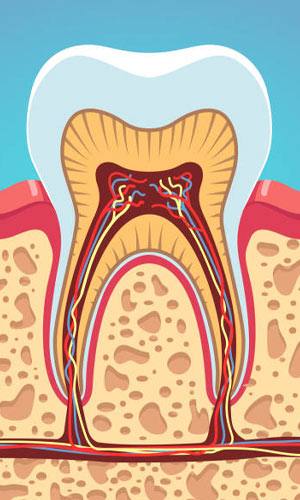What is Root Canal Treatment?
Root canal treatment, also known as endodontic therapy, is a dental procedure designed to treat infection at the center of a tooth (the root canal system). This treatment is often necessary when the pulp, the soft tissue inside the root canal, becomes inflamed or infected. The inflammation or infection can have various causes: deep decay, repeated dental procedures on the tooth, faulty crowns, or a crack or chip in the tooth. Sometimes, even if the tooth has no visible chips or cracks, the pulp can become inflamed or infected.
Understanding the Anatomy of a Tooth
To fully grasp what root canal treatment entails, it's essential to understand the basic anatomy of a tooth. A tooth is made up of several layers
- Enamel: The hard, outer surface of the tooth.
- Dentin: The layer beneath the enamel, which is not as hard and protects the innermost part of the tooth.
- Pulp: The soft tissue at the core of the tooth, containing nerves, blood vessels, and connective tissue.
The pulp extends from the crown of the tooth to the tip of the roots, where it connects to the tissues surrounding the root. The pulp is vital during a tooth's growth and development but is not necessary for the tooth's function after it has fully matured.
Why is Root Canal Treatment Needed?
Root canal treatment is needed when the pulp becomes inflamed or infected. Without treatment, the infection can spread, leading to severe pain or the development of an abscess. The common reasons for pulp damage include
- Deep decay: Untreated cavities that reach the pulp.
- Repeated dental procedures: Multiple restorations on a single tooth.
- Cracked or chipped tooth: Trauma or accidents causing cracks or chips.
- Faulty crowns: Poorly fitted crowns that lead to pulp damage.
Symptoms indicating the need for root canal treatment include severe toothache, prolonged sensitivity to hot or cold, discoloration of the tooth, and swelling and tenderness in nearby gums.

Dr.M. Mani Deepika
BDS
Endodontics(root canal specialist)

The Root Canal Procedure: Step-by-Step
Root canal treatment typically involves several steps, which can be completed in one or more dental visits depending on the severity of the infection and the tooth's condition.
Diagnosis and Treatment Planning
The process begins with a thorough examination by the dentist or endodontist, who specializes in diagnosing and treating issues inside the tooth. Diagnostic tests include X-rays to assess the extent of the infection and to visualize the shape of the root canals.
Local Anesthesia
Before the procedure starts, local anesthesia is administered to numb the affected tooth and surrounding area. This ensures the patient is comfortable and pain-free during the treatment.
Isolation of the Tooth
A rubber dam is placed around the tooth to keep it dry and free from saliva during the procedure. This isolation helps in maintaining a clean and sterile environment.
Access Opening
The dentist creates an opening in the crown of the tooth to access the infected or inflamed pulp. This is usually done with a dental drill.
Removal of Infected Pulp
Using special instruments called files, the dentist removes the infected or inflamed pulp from the pulp chamber and root canals. The canals are then cleaned and shaped to prepare them for filling.
Disinfection
The cleaned root canals are disinfected with antimicrobial solutions to eliminate any remaining bacteria and reduce the risk of further infection.
Filling the Canals
After cleaning and disinfecting, the root canals are filled with a biocompatible material called gutta-percha. This rubber-like material seals the canals to prevent future bacterial contamination.
Sealing the Tooth
A temporary filling is placed in the opening of the tooth to seal it until a permanent restoration (such as a crown) can be placed.
Restoration
In most cases, a tooth that has undergone root canal treatment will require a crown to restore its strength, function, and appearance. The permanent restoration is typically placed during a subsequent visit.
Post-Treatment Care and Recovery
After a root canal treatment, it's normal to experience some discomfort or mild pain for a few days. Over-the-counter pain relievers like ibuprofen can help manage this discomfort. It's important to follow the dentist's post-treatment care instructions, which may include
- Avoiding chewing on the treated tooth until it is fully restored with a crown
- Maintaining good oral hygiene by brushing and flossing regularly.
- Attending follow-up appointments to monitor the healing process and ensure the tooth is restored properly.
Benefits of Root Canal Treatment
Root canal treatment offers several benefits, including
Pain Relief
The primary benefit of root canal treatment is the relief from severe tooth pain caused by pulp inflammation or infection.
Preservation of the Natural Tooth
Root canal treatment saves the natural tooth, which is always preferable to extraction. Preserving the natural tooth helps maintain the structure of the jaw and bite alignment.
Prevention of Infection Spread
By removing the infected pulp and sealing the root canals, root canal treatment prevents the spread of infection to other teeth and surrounding tissues.
Restoration of Function and Appearance
A properly restored tooth after root canal treatment functions like any other tooth and blends seamlessly with the surrounding teeth
Myths and Misconceptions About Root Canal Treatment
Despite its benefits, root canal treatment is often misunderstood, leading to several myths and misconceptions.
Myth 1: Root Canal Treatment is Painful
One of the most common myths is that root canal treatment is extremely painful. However, modern dental techniques and anesthesia make the procedure no more uncomfortable than getting a regular filling. Most patients find relief from the pain caused by the infection after the treatment.
Myth 2: Tooth Extraction is a Better Option
Some people believe that extracting the tooth is a better solution than undergoing root canal treatment. However, preserving the natural tooth is always the best option. Extractions can lead to other dental issues, such as shifting teeth and bone loss.
Myth 3: Root Canals Cause Illness
There is a misconception that root canal treatment can cause other illnesses. This myth stems from outdated research and has been debunked by contemporary studies showing that root canal treatment is safe and effective.
Advances in Root Canal Treatment
Advances in dental technology and techniques have made root canal treatment more efficient and comfortable for patients. Some of these advancements include
Digital Imaging
Digital X-rays and 3D imaging allow for more precise diagnosis and treatment planning. These technologies help dentists visualize the root canal system in detail and identify any complex anatomy that needs special attention.
Rotary Instruments
Modern rotary instruments made from nickel-titanium are more flexible and efficient than traditional stainless steel files. They allow for more effective cleaning and shaping of the root canals.
Apex Locators
Electronic apex locators provide accurate measurements of the root canal length, reducing the need for multiple X-rays and ensuring precise cleaning and filling.
Laser Dentistry
Lasers can be used to disinfect root canals more effectively and reduce bacteria levels, enhancing the overall success rate of the treatment.
Microscopes and Magnification
Dental microscopes provide enhanced visibility of the root canal system, allowing for more precise and thorough treatment.
When to See a Dentist
It's crucial to see a dentist at the first sign of tooth pain or discomfort. Early diagnosis and treatment of dental issues can prevent the need for more extensive procedures like root canal treatment. Regular dental check-ups and cleanings are essential for maintaining good oral health and catching problems early.
Root canal treatment is a highly effective procedure for saving teeth that would otherwise need to be extracted due to infection or inflammation. Understanding the process, benefits, and advancements in root canal treatment can help alleviate any fears or misconceptions about the procedure. With proper care and restoration, a tooth that has undergone root canal treatment can last a lifetime, preserving your natural smile and oral health. If you experience any symptoms of tooth infection, don't hesitate to contact your dentist and seek timely treatment.
